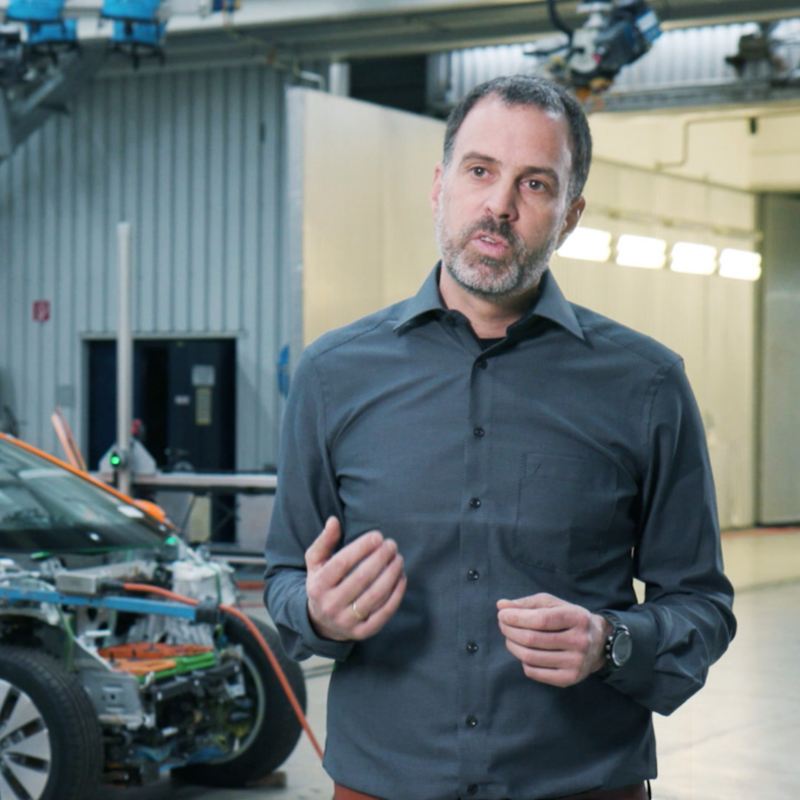Crash simulation: safety via supercomputer
Crash simulation: safety via supercomputer
The new ID.3 architecture also poses new challenges for vehicle safety. Find out what they are and how a supercomputer with virtual crash situations helps when developing a new airbag.
The development of a new airbag for the ID.3, which opens between the two front seats, was initially carried out entirely virtually on a computer. How did this work and how did a supercomputer pre-calculate suitable crash situations? Ernst Glas, manager responsible for vehicle safety calculation, explains.
At what point did you realise that electric mobility is about to make a breakthrough for everyone?
In the course of the project, I realised that it would be possible to overcome the extremely high hurdle an affordable price with the necessary range. At the same time, this became a massive issue in social media and other media. This made the need for a technological transformation even more pressing – and by then, at the latest, I knew that we were headed in the right direction with the ID.3.
What was the biggest challenge you faced over the entire course of the project?
Imagine this: in the ID.3, we have a rigid platform – a chassis known as the MEB (modular electric drive matrix) – with a battery block at its centre. This is not simply a battery and an electric motor that are installed below the chassis. Rather, the “Vehicle Safety” department has to work with its colleagues in Body Design to find new solutions that optimally support such a revolutionary vehicle architecture. The electric-specific components, such as the high-voltage battery and the high-voltage cables, have to be well protected in the event of an accident because damage in a possible crash is absolutely unacceptable.
In addition to this, the centre airbag was a new technical field for us. This airbag is also relatively new in the automotive world and prevents the heads of the driver and front passenger from colliding – for example if the ID.3 overturns. The requirement for this security feature arose relatively spontaneously and at short notice – and we did not have any existing technology or development to fall back on. So we pulled out all the stops in simulation and testing and ultimately found a very good solution, which we are all proud of. Because this technology makes the ID.3 even safer than it already is.
Vehicles like the ones from ID. family are forcing a technological shift that is urgently needed. It`s a good feeling to be a part of it.Ernst GlasSimulation Vehicle Safety
In detail: which technology do you find most fascinating in the new ID.3?
Personally, I am fascinated by driving electrically and at the same time long distances. I am strongly moved by the idea of generating electricity from the photovoltaic system on the roof of the house and, thus, driving with zero emissions. I am really looking forward to my first ID.3!
What inspired you the most when developing the ID. family?
The ID. family and the ID.3 are absolutely new technical territory – for all of us. For me the question was whether we would succeed in making the car both affordable and attractive for many people at the same time. Of course, we asked ourselves: How do we make an electric car safe for the mass market? All in all, this involved a great many new challenges; it was – and of course still is – a pleasure to tackle these tasks.
What will you take away from this project personally?
The demands on the project were truly enormous. But we have succeeded – through a massive joint effort. It gives us all the courage to venture into new territory and to face challenges, even if they seem almost insurmountable at first. One thing is directly connected to this successful development work: we must change our energy and material cycles worldwide. This project gives me the confidence that we can achieve this.
What noticeable advantages result from digital simulation solutions – such as pre-calculations of a crash?
The requirements placed on a car today are generally and, especially in vehicle safety, so complex that they can only be met with the help of simulations. Because only simulations can assess the function with the necessary depth. An example: simulations independently determine the optimal shape of a component. Supercomputers (“topology optimisers”) can find a highly optimised result in the shaping of the profile of side skirts within the space of several days by specifying boundary conditions such as the material or wall thickness of individual areas. In such a way that the battery is protected, the body and chassis can absorb as much energy as possible and so that the occupants experience the maximum possible safety. In addition, this method can be used to eliminate a great deal of weight from the car – especially in the case of side skirts, because they are such large components and, therefore, require a lot of material. The opportunities that simulations now offer are a major advance in themselves. Simulations have become indispensable. And we continue to work toward overcoming every technical challenge with it.




